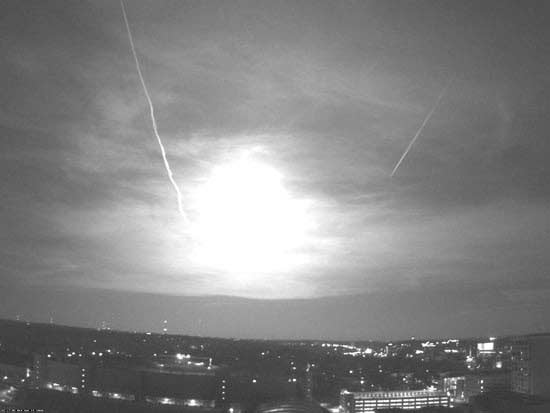Meteor Fragment From Wisconsin Fireball Discovered by Farmer

A small chunk of rock believed to be a fragment from ameteor that burst into a stunning fireball over Wisconsin Wednesday night wasdiscovered by a farmer after it fell on the roof of his shed.
The meteor fragment is peppered with gray, white and reddishminerals, though one side is covered in what scientists called a "fusioncrust" ? a layer of dark material forged during the meteor's fiery passageinto Earth's atmosphere. It weighs just 0.2 ounces (7.5 grams) and is about 2inches (5 cm) long and less than an inch wide.
A camera mounted to a campus building at the Universityof Wisconsin-Madison caught the Wisconsinmeteor's explosive demise. The meteor's sonic boom and explosion were alsoseen and heard by numerous witnesses, and sparked frantic 911 emergency callsacross six different states, according to the Near-Earth Object Office at NASA'sJet Propulsion Laboratory (JPL) in Pasadena, Calif.
When the meteor exploded, it unleashed as much energy asthe detonation of 20 tons of TNT, NASA scientists said. Their analysis foundthat the parent meteor was about 3.3 feet (1 meter) wide before it blew apart.
The first reported piece of the space rock was discovered by a Wisconsin farmerThursday morning and brought to the University of Wisconsin-Madison for analysis.
The space rock was not associated with the GammaVirginids meteor shower, which was under way at the time. Instead, it mostlikely came from the asteroid belt, NASA scientists said.
Scientists at the geosciences department of theUniversity of Wisconsin-Madison studied the meteor fragment briefly using ascanning electron microscope and an X-ray spectrometer. The rock includestraces of magnesium, iron and silica compounds, as well as other commonminerals like olivine and pyroxene.
Get the Space.com Newsletter
Breaking space news, the latest updates on rocket launches, skywatching events and more!
The meteor fragment also contained iron-nickel metal andiron sulfide, minerals typically found in primitive meteorites discovered onEarth, but scientists hope to see more pieces of the exploded meteor forcomparison.
"Until we look at more samples and are able to takesome measurements, we won't know what kind of meteorite it is," saidNorika Kita, a meteorite expert at the university who studied the meteorfragment with colleague Takayuki Ushikubo.
Researchers are convinced more fragments exist based onthe first sample's "fusion crust," which is only on one side of therock.
"If the meteorite had broken up high in theatmosphere it would have developed a fusion crust that completely covered theexterior," explained geosciences professor John Valley also of the University of Wisconsin-Madison. "Thisdoesn't have that, so it broke up low enough that I'd have to say more of ithit the ground."
The discovery of meteor fragments and meteorites known tohave entered Earth's atmosphere over Wisconsin is exceedingly rare, universityofficials said.
Only a dozen meteorites have been documented inWisconsin, with shards from seven of them recovered and on display at the Universityof Wisconsin-Madison's Geology Museum.
Most of those are more than 50 years old.
Objects as big as washing machines typically fallinto Earth's atmosphere on a monthly basis, but most burn up beforereaching the ground. Many of the resulting fireballs are not seen because theyoccur over remote areas or over the ocean. Earth is more than two-thirdsocean.
"The frequency of space debris entering ouratmosphere that is large enough to generate a fireball is something on theorder of once or twice a day," said Don Yeomans, manager of the Near-EarthObject Office at JPL. "What is somewhat unique about this one is that itwas witnessed by so many and captured on tape. Sounds like it was spectacular.I wish I had been there to see it, too."
University of Wisconsin-Madison officials are asking anyonefinding pieces of the meteorite to bring them to the UW-Madison Geology Museumat 1215 W. Dayton St. in Madison.
Meanwhile, avid skywatchers have a chance to see meteors again in the nightsky. The Lyrid meteorshower should be visible to observers on clear nights between April 16 andApril 22.
Anywhere from 10 to 20 meteors an hour could be seen,according SPACE.com skywatching columnist Joe Rao. ?
- Images- The Best of Leonid Meteor Shower
- ImpactCraters: Earth and Beyond
- LyridMeteor Shower Peaks April 22
Join our Space Forums to keep talking space on the latest missions, night sky and more! And if you have a news tip, correction or comment, let us know at: community@space.com.

Tariq is the Editor-in-Chief of Space.com and joined the team in 2001, first as an intern and staff writer, and later as an editor. He covers human spaceflight, exploration and space science, as well as skywatching and entertainment. He became Space.com's Managing Editor in 2009 and Editor-in-Chief in 2019. Before joining Space.com, Tariq was a staff reporter for The Los Angeles Times covering education and city beats in La Habra, Fullerton and Huntington Beach. In October 2022, Tariq received the Harry Kolcum Award for excellence in space reporting from the National Space Club Florida Committee. He is also an Eagle Scout (yes, he has the Space Exploration merit badge) and went to Space Camp four times as a kid and a fifth time as an adult. He has journalism degrees from the University of Southern California and New York University. You can find Tariq at Space.com and as the co-host to the This Week In Space podcast with space historian Rod Pyle on the TWiT network. To see his latest project, you can follow Tariq on Twitter @tariqjmalik.









